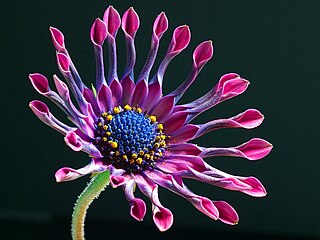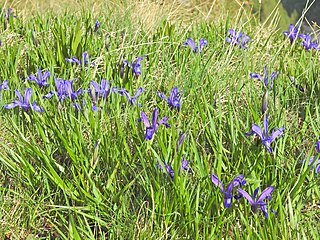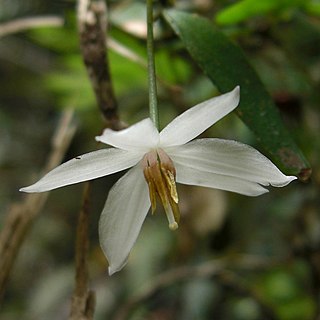See also
- Botanical nomenclature
- Cultivated plant taxonomy
- Horticultural botany
- Liberty Hyde Bailey
A horticultural flora, also known as a garden flora, is a plant identification aid structured in the same way as a native plants flora. It serves the same purpose: to facilitate plant identification; however, it only includes plants that are under cultivation as ornamental plants growing within the prescribed climate zone or region. Traditionally published in book form, often in several volumes, such floras are increasingly likely to be produced as websites or CD ROMs.
Horticultural floras include both cultigens (plants deliberately altered in some way by human activity) and those wild plants brought directly into cultivation that do not have cultigen names. They might also include colour images and useful information specific to the zone or region including:
Written by a professional plant taxonomist or plantsperson, a horticultural flora assists clarification of scientific and common names, the identification of plant characteristics that occur in cultivated plants that are additional to those in wild counterparts, and descriptions of cultivars.
Although horticultural floras may include a range of food plants, their emphasis is generally on ornamental plants and so these floras are sometimes referred to as "garden floras". Increasingly they provide data for sustainable landscaping, such as:
Numerous encyclopaedic listings of cultivated plants have been compiled but only four substantial horticultural floras have ever been produced, these being for: North America; [1] Europe; [2] [3] South-eastern Australia, [4] Hawaii and the tropics. [5]
There are several publications on trees which follow the format of botanical keys and descriptions for the trees of a specific region, notably for North America [6] and California. [7]

A cultivar is a kind of cultivated plant that people have selected for desired traits and which retains those traits when propagated. Methods used to propagate cultivars include division, root and stem cuttings, offsets, grafting, tissue culture, or carefully controlled seed production. Most cultivars arise from deliberate human manipulation, but some originate from wild plants that have distinctive characteristics. Cultivar names are chosen according to rules of the International Code of Nomenclature for Cultivated Plants (ICNCP), and not all cultivated plants qualify as cultivars. Horticulturists generally believe the word cultivar was coined as a term meaning "cultivated variety".

Abutilon × hybridum is a species name used for a wide variety of different types flowering plants of uncertain origin in the genus Abutilon. Because of the uncertainty surrounding the name, they are often considered a cultivar group: Abutilon x Hybridum Group or Abutilon Hybridum Group. They are cultigens, not occurring in the wild. As with the larger genus Abutilon generally, they have been referred to by the common names Chinese lantern, and parlour maple.

Iris ser. Longipetalae is a series of the genus Iris, in Iris subg. Limniris.

Lomelosia caucasica, the Caucasian pincushion flower, pincushion-flower or Caucasian scabious, is a species of flowering plant in the family Caprifoliaceae, native to the Caucasus, north eastern Turkey, and northern Iran. Growing to 60 cm (24 in) tall and broad, it is a clump-forming perennial with grey-green, divided leaves. Pincushion-shaped buds, borne on erect hairy, stems, open to pale blue or lavender flower heads, 4–8 cm (2–3 in) in diameter, from late summer through to autumn.

Iris xiphium, commonly known as the Spanish iris, is an iris native to Spain and Portugal. It has also been found in Corsica, South West France, southern Italy, Algeria and Tunisia. This species is also known as the small bulbous-rooted iris or xiphium iris.
A cultigen, or cultivated plant, is a plant that has been deliberately altered or selected by humans, by means of genetic modification, graft-chimaeras, plant breeding, or wild or cultivated plant selection. These plants have commercial value in horticulture, agriculture and forestry. Plants meeting this definition remain cultigens whether they are naturalised, deliberately planted in the wild, or grown in cultivation.

Nomocharis was a genus of flowering plants in the family Liliaceae. It consisted of about 7 species native to montane regions of western China, Myanmar, and northern India. They are similar to Lilium, with one of the more obvious differences being the flowers being more shallow or sometimes flat.

Commelina tuberosa is an herbaceous perennial plant in the dayflower family which is native to Mexico but grown worldwide as an ornamental plant. It is characterized by its purple-splotched spathes with free margins, its bright blue petals of equal size, its tuberous roots, and its four to ten flowered lower cymes. In the wild, it is encountered in moist fields, open forests, or pine-oak forests. The species is sometimes considered to include the species Commelina coelestis, Commelina dianthifolia, and Commelina elliptica, such as in the Flora Mesoamericana. When these are treated as separate, they are often referred to as the "Commelina tuberosa complex". Horticulturally, the species are often treated as separate entities because of their differing habits and leaf shapes. In this sense, Commelina tuberosa is a low-growing plant with long narrow leaves.

Muscari neglectum is a perennial bulbous flowering plant in the asparagus family Asparagaceae. Members of this genus are commonly known as grape hyacinths, and M. neglectum is known as common grape hyacinth or starch grape hyacinth. Muscari are perennial bulbous plants native to Eurasia. They produce spikes of dense, commonly blue, urn-shaped flowers. It is sometimes grown as an ornamental plant, for example, in temperate climates as a spring bulb.

Cultivated plant taxonomy is the study of the theory and practice of the science that identifies, describes, classifies, and names cultigens—those plants whose origin or selection is primarily due to intentional human activity. Cultivated plant taxonomists do, however, work with all kinds of plants in cultivation.
Iberodes commutata is a species of flowering plant in the family Boraginaceae. It is an annual endemic to Cádiz and Málaga provinces of southern Spain. It has a conical receptacle.

Euphorbia trigona, the African milk tree, cathedral cactus, or Abyssinian euphorbia, is a species of flowering plant that originates from Central Africa. Somewhat common in cultivation as a houseplant or as a hedge, the species is one of the euphorbias with succulent stems and branches as an adaptation to arid climates.

Iris ser. Chinenses is a series of the genus Iris, in Iris subg. Limniris.

Iris ser. Tripetalae is a series of the genus Iris, in Iris subg. Limniris.

Iris ser. Ruthenicae is a series of the genus Iris, in Iris. subg. Limniris.
Sedum multiceps, also known as miniature/pygmy Joshua tree, is a perennial, deciduous species of Sedum from the succulent plant family Crassulaceae, native to Algeria. The plant is nicknamed for its glaucous leaves that grow in clusters, resembling Yucca brevifolia. It was named officially as a distinct species in 1862.

Hypericum hookerianum, or Hooker's St. John's Wort, is a perennial shrub in the flowering plant family Hypericaceae native to eastern and southern Asia. The specific name hookerianum is named for William Jackson Hooker.

Luzuriaga radicans is a species of flowering plant in the genus Luzuriaga of the family Alstroemeriaceae (Inca-lilies), part of the monocot order Liliales. It is native to Chile and Argentina.

Kalanchoe porphyrocalyx is a species of Kalanchoe native to Madagascar.

Citrus margarita, the oval kumquat or Nagami kumquat, is a species of kumquat; a type of citrus fruit in the genus Citrus, family Rutaceae. Its epithet, margarita, is Latin for pearly.